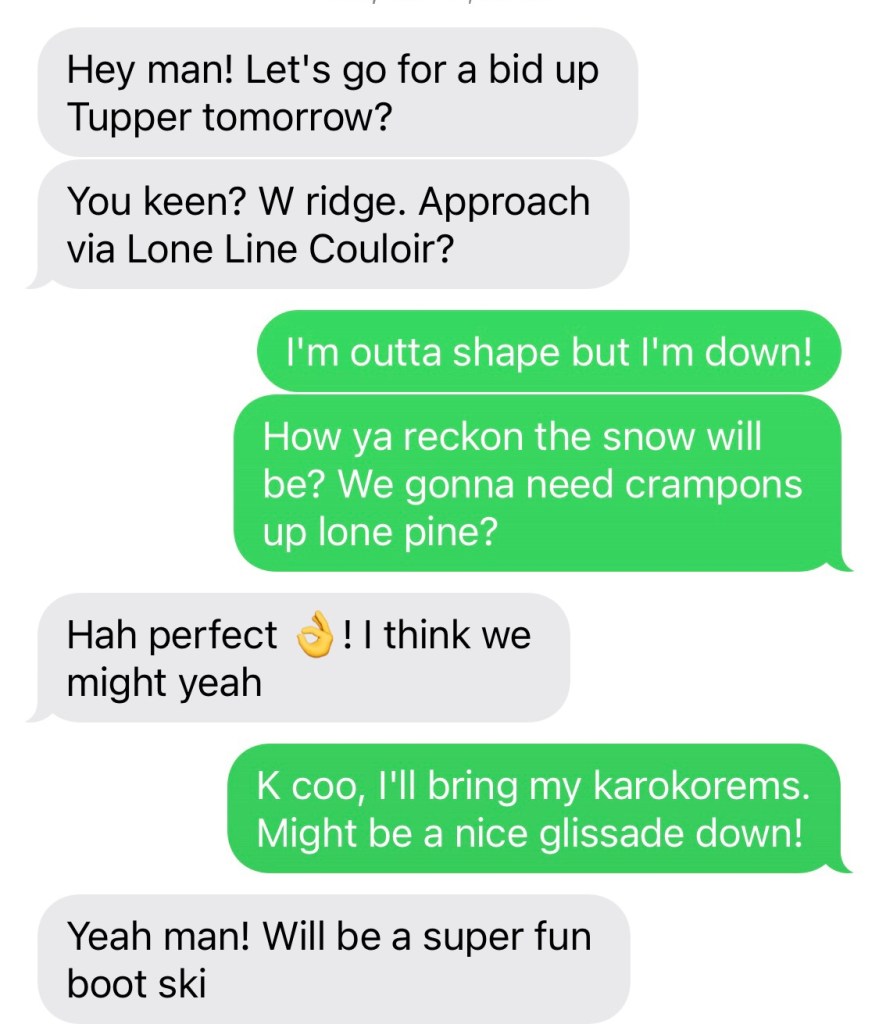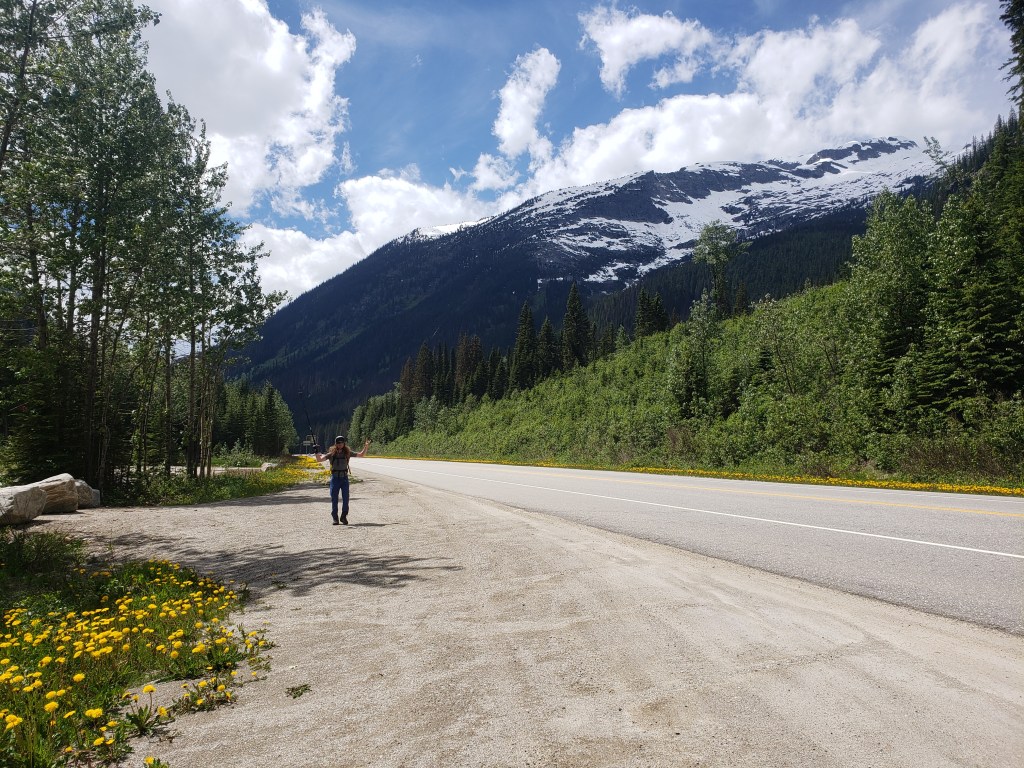Mount Tupper West Ridge, PD 5.4-5.6
Personal Rating: ****
Rock Quality: 8/10
Length: 2 pitches of 5th class, 800m of 4th class
Timeline (Bivy – Bivy): 8 hours
Gear: #0.75 – #2 + ½ set nuts
The sound of my crampons and ice axe shaft caused a steady rhythm to become the backdrop for me experience, “shhhink, tink tink shhhink, tink, tink”, the familiar balance of calculated movement working naturally. I am calm, ascending swiftly uphill; almost directly, each step another meter of elevation gained. It’s a late June morning and due to the larger than average snowpack from the previous winter we are able to easily ascend the Lone Pine couloir leading directly to our objective, the West Ridge of Mt. Tupper.

I appreciate these early-season alpine missions more and more. Ascending a couloir has it’s benefits, no dealing with long winding switchbacks on the way up, minimal alder bashing to approach a rock gully, and lastly the ability to enjoy a gravity assisted descent. On this particular day we decided to go back down the same gully with my second favourite method (next to snowboarding of course)… the ol’ boot ski – no hiking downhill, no drumming again and again on the patella – saving the knees one day! Just two Vibram soles, and 1400 meters of 30-35 degree couloir ridden on the back of your heels. I decided this would be a perfect June mission.
I threw a text out to my buddy Jake:

It was all set.
Our day began early, my buddy cruised by around 4am in Revelstoke, BC. I’d admittedly woken up later than expected so my menu was limited – a bowl of oats and a coffee to go. We hopped on highway 1 and cruised East until we reached the Roger’s Pass Summit, in Glacier National Park (Canada’s of course). Instead of using the designated parking lots, we drove a little ways further utilizing a large pullout directly across from the Lone Pine Couloir (Named in the regions backcountry ski guide). We took count of the gear necessary in case we decided to rope up (we carried a ½ rack of cams between 0.5-2 and a few larger nuts), shouldered our packs and set out.
As expected, alder bashing was needed to reach the base of the snow gully. By sticking in the treeline East of the couloir, we found the going relatively smooth, with only downed wood to contend with… instead of the 15’ cross hatched, woven alder located in the gully’s center. We climbed a rough 70m of elevation gain, to the snowline. Punched directly across the slope, suffering only slightly in another thicket of slide alder. Whether by science or coincidence, we happen to reach the base of the snow gully about 10m above where it petered out into rock, the first high five was quickly had!
We started our ascent utilizing sun cups – melted dishes in the frozen snow – to propel ourselves up the low angle snow. 30 minutes later however, we were dawning crampons and drawing our piolets/ice axes. I saw a slightly confused on my partners face, realizing then that he hadn’t brought his mountaineering axe with him. A slight bummer, but given the other hiking poles I’d brought we weren’t too concerned. Despite our best laid efforts, something always gets left behind. Luckily, I did have a ski pole with me to provide some means of stability as we began to ascend steeper and steeper ground.

Conversation flowed easily, and we found ourselves deep in existential discussion, as if we’d tapped into that finicky faucet where the simple flow of life comes out in full volume – a faucet that can seem like just a trickle in other situations. Something about the fresh air, simple nature of the task, and very real confrontation with our own mortality, all combine, making it easy to speak candidly. Each step went by unnoticed like the last, and upward progress felt easy and was inevitable.
Despite the efficiency of walking up a comfortable ‘ladder’ to the route, we weren’t having any illusions about the dangers and exposure of this approach. Most couloirs are a bowling alley for falling rocks and debris that becomes loosened by the warming sun on the peaks above. To help mitigate this exposure we decided to start plenty early, before the sun rose and began its’ beautiful but dangerous thawing process on the quartzite walls above.
Our footing was relatively secure and travel easy, the firm snow and the the couloir steeping to a pitch greater than 48 degrees, began to require a more intense focus. The skating rink firmness of the snow made us second guess our descent route and method; 1400m of fall line boot skiing from ridgeline to highway may be a bit of an issue.
We reached an exposed crossing beneath a large headwall where we had to traverse in order to reach our starting point just as the sun starting to crest the mountains to the West. With a subtle nod of understanding between us we quickened our pace and by 8:30am we reached the a slight col along Tupper’s West Ridge. We stripped off our mountaineering boots, crampons, and ice tools and stashed them under a rock nearby. Dawning some lightweight approach shoes and carrying a pack with rope, harness, and a few pieces of protection we set off along the ridge.
The climbing itself is very enjoyable. Mostly 4th class ridgeline traversing, with the odd 5th class step here and there. The 1st section of traversing is almost hands-free, as you hop and weave between large quartzite boulders, we were being careful to tread lightly after the spring thaw. There is one slightly exposed 4th class move around two of the larger boulders, and a funky “au cheval” step that I personally felt comfortable just using as a hand hold while stepping down below. (Au Cheval means ‘horse’ and the step typically involves straddling a piece of rock and butt sliding forward)



We then reached the vertical summit block. From here the vertical climbing really begins with a variety of cracks to ascend. We decided that we each felt comfortable enough to leave the rope safely stored in the pack and continue to solo the route. Jake chose the 5.4 chimney pitch, an awkward, “butt-scooching” style of climbing, made a little weird with a pack. It is the least exposed of the options, but likely the least desirable.
I chose the 5.6 corner variant, which is also a large crack system that can be climbed in an off-width style, utilizing the many face holds available as well. I decided to tie into my rock shoes in order to provide some extra security and before long I saw Jake’s wiley head pop over the top just as I was pulling the last few easy layback moves with solid feet. It was a great pitch, but the real money was the 5.8 crack to its left – a beautiful splitter hand-crack that looked easily protectable.
The final summit push featured a slight bulging overhang that I took first. Jake soon followed (after a few comedic & morbid remarks such as, “you WILL watch me if I die!”).. After that final crux we easily cruised the 3th class terrain to the summit proper.
We couldn’t believe it, 6 hours from the time we closed the car door, to standing on the summit was an impressive achievement for both of us and high-fives were in surplus. We sat down to soak in the sun, send a message on the inReach, and garble down a bit of grub. We both agreed that things had been going swimmingly, the crux we felt, would be the descent down the Lone Pine couloir.



Putting our harnesses on and unpacking the rope we began our descent back along the summit block, using 3 or 4 rappels (3 fully-bolted). This easily brought us back to the West Ridge 4th class terrain where we packed up the rope and gear and began our traverse back to the col. Although I’m aware that a downward sloping traverse causes some people a 2nd glance, we felt it was quite secure and straight-forward.

Back at the col we reached a decision point: do we boot ski this 1400m descent, or post-hole (deep boot holes) down the snow covered trail for the next 4-6 hours…. There wasn’t much of a decision. We tied into our heavy boots, grabbed our weapon of choice (I chose my ice axe, and Jake took the leftover ski pole… not much of a choice) and looked down into the belly of the best.
I jumped first, two feet ready to brace beneath me and my tool at the ready to self-arrest my descent. I expected to feel the firm snow sliding under my stiff rubber soles, but instead I plunged about 1 foot into the snow and felt the resistance, support, and ultimately control the warmed snow now provided. While our ascent had been rock solid, our descent was now thawed slushy snow. I let out a few ‘hoots’ and ‘yeeews’ to express my excitement and we both began to rip down the couloir with smiles on our faces.
While we were having the time of our lives, we also let it get a little too loose at times. A 7’ wide runnel had formed down the center line of the slide-path and was a black hole vortex that sucked in every rock, dirt, and debris into it’s beckoning arms. If we let ourselves get going too fast we quickly found ourselves being summoned into its icy slopes and pulled closer to the dangers of the rocks it held. More than once I had to flip over onto my ice axe to arrest myself.
Soon though, we found ourselves below most of the obvious dangers and we could enjoy the rush that boot skiing provides. I’ve ridden Lone Pine a handful on my trusty Splitboard with sharpened edges and fast polymer base, but never until now have I felt the warm, stomach-churning feeling that comes with the overall insecurity and looseness of the boot ski.


We found ourselves at the bottom of the gully, smiles on our faces, wet snow on our bums, and joy in our eyes as we packed away the snow tools and headed back into the slide alder. After only about 15-minutes we reached the side of Hwy 1, no doubt an interesting sight for the truckers and travelers that happened to see two disheveled looking gentlemen, one with a large lions mane for hair, the other a freshly cut mullet, shouldering climbing packs as we arose from the woods.

We took a look at the time and we’d made the descent in 2-hours, for a total time out of 8 hours. Back at the truck we cracked a couple Kootenays and looked skyward at the objective we’d just ascended and descended. We agreed it was easily the smoothest alpine climbing experience either of us had had, and we relished in the feeling that comes with moving efficiently and doing something well. With many laughs along the way, I learn more and more that the best climbs have a little to do with the climbing, and a lot to do with the company shared.
This one would be another feather in the cap for both of us.
It’s exzilerating reading . Never to be done but happy to live it through your vivid writing /blog.
LikeLike
A breathtaking read and I love how you enjoy yourselves on the journey 🥰
LikeLike